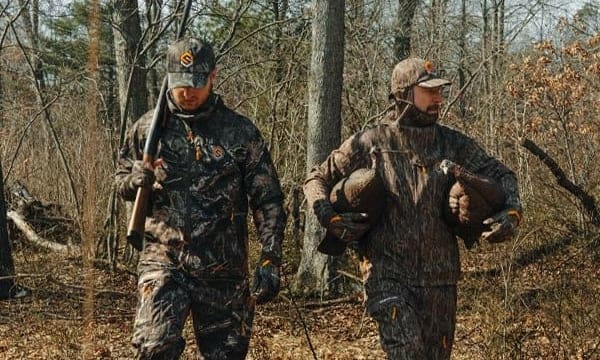The sound of spring tom turkey gobbles echoing through the trees is like no other. Back-and-forth gobbling between male turkeys isn’t just simple communication; it helps establish a critical pecking order that determines dominance between mature male turkeys during the breeding season. Meanwhile, the hens are listening and taking note of the vocal responses they’re receiving from gobblers as a result of their own purrs, putts, and yelps. Whatever the reasons, most hunters agree that the gobbling of a mature tom is what keeps their blood pumping in the spring turkey woods.

One of the only times a hunter does not enjoy the sound of a turkey gobbling is after sitting for a decent length of time while calling, only to realize that the gobbler is hung up and won’t come any closer. The frustrating experience can happen frequently; a tom is responding to a call and closing the distance to the hunter nicely, then encounters some type of obstacle that causes him to stop. When this happens, the stubborn tom will typically stay put while gobbling periodically in hopes the hen will come to him as mother nature intended. The outcome is rarely good for the hunter, who is often forced to give up and leave empty-handed or back out and re-locate in an attempt to get in a better position and try again.
Several things can cause a gobbler to hang up or not respond to calling. In my experience, the number-one cause is usually one or more hens. When a gobbler has hens with him, he often simply ignores other hens, or the hunter trying to create the illusion of a hen through decoys and calling. A real hen with a gobbler causes challenges for any turkey hunter, even the best callers in the world. One common solution is to call the hens instead of the tom. If the hens respond to the call, the gobbler will surely be close behind. Another way to compete against a henned-up gobbler is to outsmart him by knowing where he is going and to be there waiting when he shows up.
Another common cause of the dreaded gobbler hang-up hang is good old Mother Nature. Natural hurdles include landscape elements like creeks, riverways, thick briars, or rough terrain that turkeys do not commonly cross when responding to the call of a hen. Other physical obstacles include man-made kind like fences. We’ve all seen it; when a gobbler encounters a fence or ditch or thick patch of cover while responding to a hen, he’ll often stay on his side, gobbling to try and get the hen to come to him.

Now that we understand the basic reasons why gobblers typically hang up, let’s talk about ways to prevent it from happening in the first place. Pre-season scouting is key.
Most turkey hunters understand the importance of scouting before the season begins, but many fall short in execution. Turkey sign, locating live birds, the areas they are using and their common travel patterns are all extremely helpful scouting outcomes, but remember to also be on the lookout for physical and geographic features and barriers that might cause a tom to hang up. Take note of fences, bodies of water, rough terrain, thick vegetation, or anything else that might deter a gobbler from coming into shooting range and finishing.
In recent years, I have used maps such as OnX Maps to help create a game plan before hunting. When I find obstacles that might hurt my chances, I simply mark them on my OnX Maps app on my phone so I can keep track of them and consider them when making decisions about the precise locations I choose to hunt. I use the same app to conduct the second part of my scouting routine, which is listening for gobbling.
For several weeks before the hunting season opens, I go to my hunting areas early in the mornings to listen for the gobbling of toms. This gives me good information on how many toms are in the area, how many hens are with them, where they are roosting, which directions they most often fly down, and the general directions they travel after doing so. Most often, I stay close to my vehicle parked on a high vantage point so I can listen and hear in a 360-degree radius. I then drop a waypoint on my app at each location where I hear a gobbler or a hen. Closer to the season-opening, I’ll travel deeper into my hunting areas to collect more information on turkey travel patterns and the best locations to hunt. The data I acquire through scouting – all logged on my app – gives me the confidence to create the shortest distance between the gobblers and where I’ll sit on opening morning, without any significant obstacles in between.
Knowing the terrain and physical features of your hunting areas – in addition to what the turkeys are doing daily – will have positive results once the season arrives. Not only will you be in the right area, but your setup also will have avoided any geographic or physical features that might result in Old Tom hanging up before he gets into range. The only thing left to determine is the quickest route back to the truck after he hits the ground.
To access a bigger advantage this turkey season, check out our apparel best fit for the occasion here.

